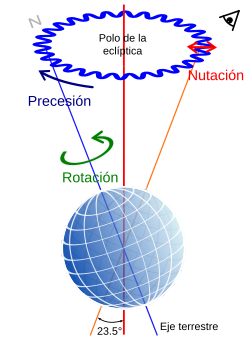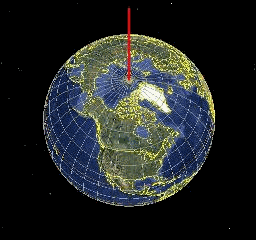Equinox precession
In astronomy, the precession of the equinoxes or axial precession is the slow and gradual change in the orientation of the Earth's axis of rotation, which causes the position which indicates the axis of the Earth in the celestial sphere moves around the pole of the ecliptic, tracing a cone and going around a complete circumference every 25,776 years, a period known as the Platonic year, similar to the wobble of a top or top. The current value of the angular displacement is 50.290966 sexagesimal seconds per year, or about 1 degree every 71.6 years.
Since Earth's poles wobble at this rate, points in the orbit where the poles are the same distance from the Sun also move at this rate and in the opposite direction of Earth's translation. When the planet reaches those points the equinox occurs and for this reason they are the equinoctial points. Its displacement in the opposite direction to the translation of the Earth determines the name of "pre-cession". What in the wobble of the axis corresponds to 50.29 seconds of arc per year, in the orbit it corresponds to about 36,300 kilometers.
This change in direction is due to the tilt of the Earth's axis of rotation about the ecliptic plane and the torsion exerted by the tidal forces of the Moon and the Sun on the Earth's equatorial bulge. These forces tend to bring the excess mass present at the equator to the ecliptic plane.
History
Historically, the discovery of the precession of the equinoxes is attributed to Hipparchus of Nicaea as the first to give the value of the precession of the Earth with an extraordinary approximation for the time. The exact dates are not known, but astronomical observations attributed to Hipparchus by Claudius Ptolemy date from 147 to 127 BC. c.
Some historians maintain that this phenomenon was already known, at least in part, by the Babylonian astronomer Cydenas, who would have noticed this displacement as early as 340 BC. C.
Description
The rotation of the Earth causes an equatorial widening, and a polar flattening of approximately 21 km. In addition, the axis of rotation of the Earth is tilted 23° 27' with respect to the perpendicular to the ecliptic (the plane containing Earth's solar orbit). Therefore, one half of the equatorial bulge lies above the ecliptic plane and the other half below. During the equinoxes, the flares on each side of the ecliptic are the same distance from the Sun, and the Sun produces no moment of force. In contrast, all the rest of the time, and especially at the solstices, the flare on one side of the ecliptic is not at the same distance as the flare on the other side, and there is a moment of force created by the ecliptic. Sun, which tends to carry the excess mass present at the equator to the plane of the ecliptic and causes the precession of the Earth.
If flattening did not exist and the Earth were spherical, the attraction of the Sun would not produce a moment of force on the Earth and there would be no change in the direction of the Earth's axis.
During a few months or years the Earth's axis is directed towards practically the same point on the celestial sphere, due to the conservation of the Earth's angular momentum.
Effects
The change in the direction of the Earth's axis of rotation causes a variation of the plane of the celestial equator and, therefore, of the cutting line of said plane with the ecliptic. This line marks the direction of the Aries point on the celestial sphere, which retrogrades on the ecliptic, a phenomenon called precession of the equinoxes. Currently the Sun reaches the Aries point on March 20, but astronomically that point is at 28º (from the border with the constellation Aries) in the constellation Pisces. The consequences of this phenomenon are:
- The celestial north pole moves in relation to the stars. Now it's close to the polar star (alpha of the Osa Menor).
- The first point of Aries, intersection of the celestial equator with the ecliptic, retrograde on the equator in the same period, that is, 50,290966" per year.

At the beginning of the Christian era the Sun was projected at the beginning of spring in the constellation of Aries. Currently, 2000 years later, it has revolved an angle of 50,2511 × 2000 = 27.92 ° and is projected in Pisces, so the stations have moved approximately one month.
And on the day of the June solstice, the Sun appears just at the end of the constellation of Gemini to precessionally enter that of Taurus while the point on the terrestrial sphere that fully receives the Sun's rays is noon on the parallel called the "Tropic of Cancer". And on the day of the solstice of December 22, the Sun, at that moment visually close to the center of the galaxy, appears on its fourth day in the constellation of Sagittarius, while the point on the terrestrial sphere that fully receives the Sun's rays is noon of the parallel called "Tropic of Capricorn".
Also, precession changes the declination and right ascension of any star. Over time the night sky changes radically. Let's take as an example the constellations of Scorpius and Orion, whose right ascensions are 17 hours and 5 hours respectively: in the northern hemisphere Scorpius is a summer constellation and Orion is a winter constellation. Within about 12,000 years both constellations will exchange their relationship with the seasons: Scorpius will be winter and Orion, summer. By then your straight ascents will be worth 5 hours and 17 hours respectively.
Currently, due to the wobble of the axis, the lower node of Earth's equator cuts the constellation Orion in half, specifically by the Belt star Mintaka. This assumes that Orion is visible from the equator at the zenith and also from the poles, and that Mintaka rises just at the east cardinal point and sets just at the west point. 3600 years ago, the equator was cut by the star Betelgeuse, which means that for the last 3.6 millennia the Earth's wobble has caused its equator to sweep Orion from above (or from below, when viewing Orion from the southern hemisphere).) up to the middle, up to the belt. And it has done so at a decreasing speed until it stops to start again in the other direction in half a millennium. It is the reflection of the wobble of the planet.
Also, currently the precession has reached the point where the December solstice occurs with the Earth in line with the Sun and the equator (or plane) of the galaxy (not the center of the galaxy, which is). at the galaxy's equator), and that transit occurs over 72 years in the full precession cycle.
Since precession proceeds at a rate of 1 orbital degree every 72 years, and since 1 degree is made up of 3600 arcseconds, it precesses at 1 orbital arcsecond every 7.3 days.
And measuring it in units of time and metrics, each year the precession moves 36,300 km. Thus, practically 100 km every day, and 1.15 meters every second, so that although we cannot rationally or linearly assimilate its duration and dimension, we can reproduce its rhythm jogging at 1.15 meters every second.
Proportionality between precessional cycle and annual cycle
Both the Earth in 365 days (common year) and the equinoctial point in 25,776 years (precessional year) cover the same number of kilometers: those of the Earth's orbit, and therefore the same space. It is rationally and linearly logical to see 25,776 years as "much longer" that the duration of 1 year and that the duration of a human life, but when the equinoctial point travels the same space as the Earth, it is a period proportional to 1 year, and also in this sense it is another dimension of time of the Earth and therefore assimilable by a temporary dimensional consciousness. Even so, we can perceive the cycle or precessional year in the same familiar way with which we perceive the common year, divided into 365 days. Thus, the precessional year is divisible into 365 parts of 70.6 years, which would be the period of 1 precessional day, which lasts one year less than the time it takes for the equinoctial point to precede 1 degree among the 360 circles.
Contenido relacionado
(1814)Bach
Quasar
Capricorn (Constellation)



